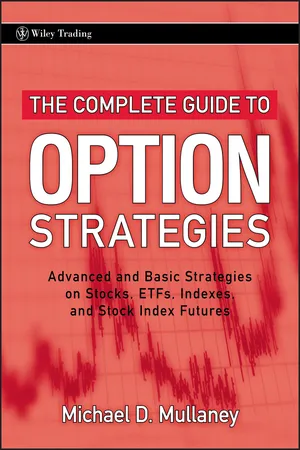Business
Options Fundamentals
Options fundamentals refer to the basic principles and concepts underlying options trading. This includes understanding the rights and obligations associated with buying or selling options, the factors that influence option prices, and the various strategies for using options to hedge or speculate on price movements. It is essential for investors and traders to grasp these fundamentals to effectively navigate the options market.
Written by Perlego with AI-assistance
Related key terms
1 of 5
3 Key excerpts on "Options Fundamentals"
- eBook - PDF
- Michael C. Thomsett(Author)
- 2005(Publication Date)
- Wiley(Publisher)
However, remember that the fundamentals are historical and have little to do with short-term price changes in the company’s stock. It is that very thing— short-term price change—that determines whether a particular option strategy will succeed or fail. While the fundamentals are essential for long-term stock selection, short-term price movement is affected more by perception of value. Indicators involving market price and perception are broadly classified under the umbrella of technical analysis. Both fundamental and technical indicators have something to offer, and you can use elements of both to study and identify stocks for option trad- ing. The distinctions should be kept in mind, how- ever, including both advantages and disadvantages of each method. The selection of options cannot be made without also reviewing the attributes of the stock, both funda- mental and technical. Whether you treat options only as a form of speculative side bet or as an important as- pect associated with being in the market, the judgment you use in selection has to apply to the characteristics and values of both the option and the stock. Criteria for the selection of high-value stocks are at the heart of smart stock market investing. The need for careful, thorough, and continuing analysis cannot be emphasized too much. So attributes such as financial strength, price stability and volatility, dividend and profit history, and others are important, not only to stockholders but to options traders as well. Picking 32 CALLS AND PUTS: DEFINING THE FIELD OF PLAY fundamental analysis a study of finan- cial information and attributes of a company’s man- agement and competitive posi- tion, as a means for selecting stocks. technical analysis a study of trends and patterns of price movement in stocks, includ- ing price per share, the shape of price move- ments on charts, high and low ranges, and trends in pricing over time. - eBook - PDF
The Mathematics of Options
Quantifying Derivative Price, Payoff, Probability, and Risk
- Michael C. Thomsett(Author)
- 2017(Publication Date)
- Palgrave Macmillan(Publisher)
To the extent that these factors affect option valuation, the fundamentals tend to define equity value over the long term, and this in turn serves as a starting point in select- ing equity investments for inclusion in an options-based hedging program. The efficiency or lack of efficiency in options pricing behavior is apparent in comparisons between stock investment versus options leverage; and differ- ences in volume levels between the two: On one hand, the leveraged nature of option contracts attracts sophisticated investors who wish to exploit public and private information. On the other hand, several institutional features of the options market make it less efficient than the stock market. For example, an option contract based on a firm’s stock typically has considerably lower trading volume than the stock itself. 2 Yet another factor in the exchange between fundamental volatility and options pricing is related to earnings surprises and changes in management guidance. The impact of both positive and negative earnings surprises is immediate and easily observed in stock charts. For example, in late February, JC Penney (JCP) experienced a positive surprise of 72.3% above expecta- tions. The price gapped higher and was strongly confirmed by a volume spike and momentum moving into the “overbought” index range (Fig. 2.1). The immediate impact of earnings as a fundamental indicator on the technical behavior of price is one example of how the fundamentals affect the technicals, in this case immediately. The clear reversal signals mark the logical point for entering trades, and options traders relying on chart analy- sis improve their timing by observing these reversal and confirmation sig- nals. However, the analytical aspects of stock price behavior are only the first 34 M.C. Thomsett step in relating the same level of news to options trading and, specifically, in how that shows up in volatility. - eBook - ePub
The Complete Guide to Option Strategies
Advanced and Basic Strategies on Stocks, ETFs, Indexes, and Stock Index Futures
- Michael Mullaney(Author)
- 2009(Publication Date)
- Wiley(Publisher)
Traditional buy and hold strategies only profit if the investment moves in one direction: higher. Although this works in many instances, many investors and traders are looking to increase their returns and manage risk. Using options wisely can be a way to do just that. As you gain experience in trading options, you should identify strategies that you like best, in view of your risk profile and profit objectives. Not only that, but some strategies may fit your lifestyle better than others, depending on whether you want to trade every day, once a week, or only once in a while. In Chapter 2, I describe key option fundamentals.Passage contains an image
CHAPTER 2Option FundamentalsBefore you begin to trade, you should understand how options work. Once you have mastered the fundamentals, you can begin to trade with confidence. This chapter covers opening and closing an option position; the fundamentals of option buying versus selling; and an introduction to margin, option spreads, the bid/ask spread, and option chain.OVERVIEW
Some option strategies are best in bull markets, some are best in bear markets, and others are best in sideways markets. Many novice option traders may be attracted to buying options because they are familiar with buying stocks (or other assets such as a home), and they are attracted to the possibility of large and unlimited profits. Buying calls can be a good place to start to learn how to trade options. You should understand the fundamentals of opening and closing an option position, the fundamentals of option buying versus selling, and other basics. We will progress in later chapters to option pricing and strategies.OPENING AND CLOSING POSITIONS
When it comes to options, the terms buy and sell can be confusing at first. You can establish (open) a position by buying an option; you can subsequently close (offset) it by selling it in the marketplace. You can establish (open) a position by selling an option; you can subsequently close (offset) it by buying it in the marketplace. Throughout this book, the terms buy and sell refer to opening/establishing positions unless otherwise indicated.At first, the idea that an open option position is offset can be a little confusing. When you purchase a stock, for instance, you sell the same shares that you bought in the marketplace; you do not offset it. But, in the unique options world, you are not dealing with ownership interests; rather, you are dealing with contracts representing rights and obligations. When you close an option position, you are taking the opposite side of the established position. The term “offset” simply means to eliminate a long or short option position that was previously established. In the options world, many option contracts are initially sold, so the term “offset” is useful to indicate that something is being closed.
Index pages curate the most relevant extracts from our library of academic textbooks. They’ve been created using an in-house natural language model (NLM), each adding context and meaning to key research topics.


